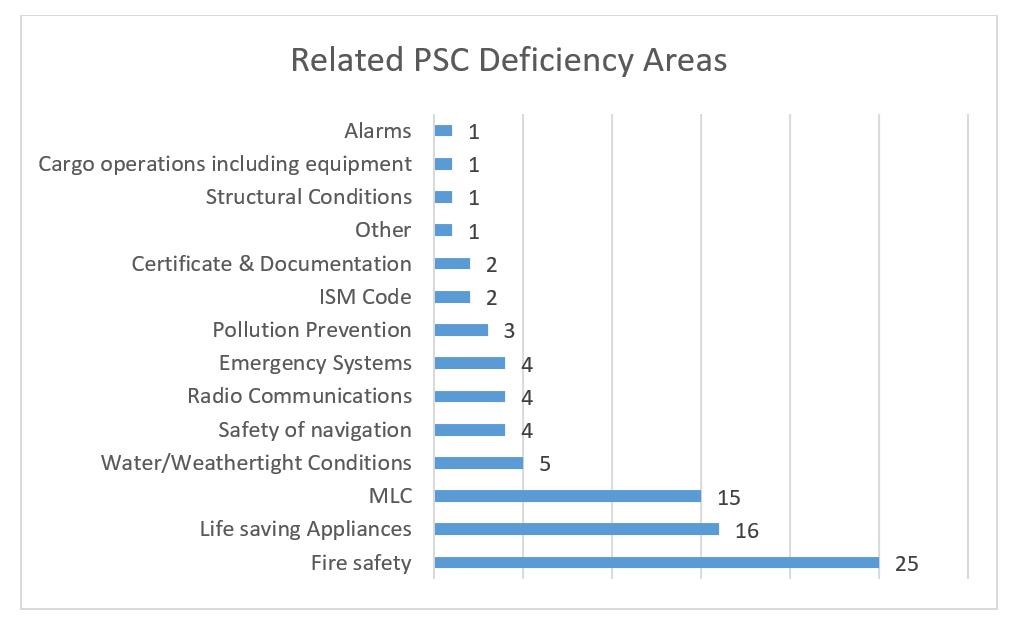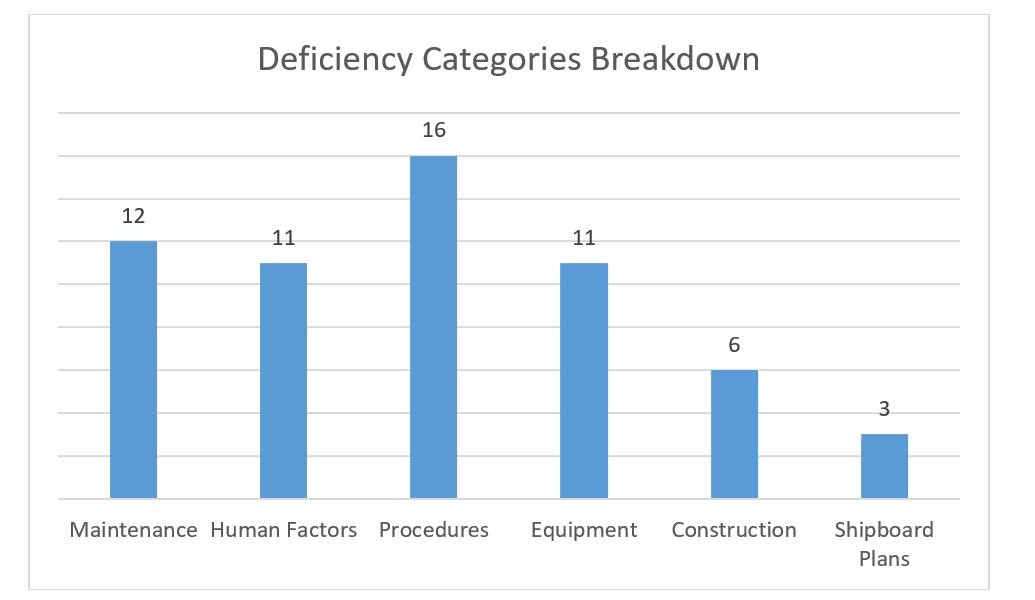On 6th of December of 2022 a Supramax Bulk Carrier Flying the Indonesian Flag, inspected in Port Elizabeth, South Africa (Port UNLOCODE ZAPLZ) resulting in a detention and 85 Deficiencies.
The following case study is based on data from the RISK4SEA online platform that offers PSC performance transparency to the market by analyzing PSC Data providing KPI, Demographics, Detentions Analytics, reports, Benchmarks and Insights for 23 fleet segments in an advanced analysis of the last 5 years
1/ Ship background
The 15 years old ship (YoB 2008, Built in P.T. PAL Indonesia – Surabaya was assessed with an Inspection Window Open given the Risk Profile of the ship and the Manager in the MoU area.
The ship’s manager was based in Jakarta Indonesia, managing a total of 2 ships and in particular 1 supramax and 1 offshore ship.
This was the first inspection under the current manager, that they had the ship under management for Seven (7) months before the inspection. Ship changed management during 2022 (May) from a Singapore based manager (operating 30 supramaxes) to current manager.
It is worth mentioning that the ship had changed classification society form one IACS member to another during November 2022, with TOCA and last class survey registered on 03/11/2022.
The ship’s PSC history during Last 36 Months included 3 inspections in Congo (2020, no findings), Benin (2021, no findings) and USA (December 2019,3 deficiencies and detention), under the previous manager.
2/ Manager Background
Manager had no previous PSC inspection history on bulk carriers and no detentions the Last 36M. As this was the first supramax in fleet no experience was available for managing this specific segment. Further more no previous PSC inspection was credited to the manager over the last 36 months (L36M) so there was an additional experience gap to PSC inspections.
3/ Port Background
In Port Elizabeth, South Africa (Port UNLOCODE ZAPLZ) for the period of the last 36 months, (prior this inspection) there were 45 inspections on Bulk Carriers from which the 39 were on supramaxes.
Port PSC History on such many deficiencies
This was the first PSC Inspection over the last 5 years with so many deficiencies. In fact there was another one inspection (not leading to detention) with 13 Deficiencies. All other inspections found to be with less than 10 deficiencies, over the course of the last 5 years before the subject inspection.
From all PSC inspections conducted the last 36 Months to 80% of them were clean inspections (0 deficiencies). Additionally, no other detention was marked in the Port the Last 36 Months (on any ship segment).
4/ Port Call Risk Assessment (POCRA)
The PSCI has been analysed with the Port Call Risk Assessment (POCRA) Risk Assessment Tool of the RISK4SEA Platform with the following outcome
PSC Inspection Probability
- The ship’s prior inspection in Indian MoU was back in 2017 so the ship was due for inspection.
- Inspections Ratio within Window Open Date ( for the last 12 months) in specific port was 94%, meaning that 9 of 10 ships with due inspection window were actually inspected.
- Manager and ship had no previous PSC history (Last 36 Months) in the Indian MoU
- No ship was reinspected (not follow up inspections) the last 12 months in the port for any reason.
- As the ship had an open Inspection window open date and the port’s practice is to inspect almost all ships with opened windows, the inspection probability was assessed as CERTAIN
PSC inspection Severity
- Ship related factors were all clear as the ships PSC history within MoU was clean (Last 36 months). The only issue that was under red flag was the ship’s age (15 years old)
- Manager PSC history within MoU was also clear. However some parameters were red flag, specifically,
- Manager DPI in Port – As manager had no experience on PSC inspections in specific port
- Ship DPI with the Manager – As manager had no experience on managing Supramaxes
Port related factors were all accessed clear as no detentions were marked the last 12 months, and the deficiency code spread for 80% of deficiencies was 13 codes (i.e. you need 13 codes to reach 80% of the total deficiencies within the port).
Having the above in mind and based mostly on the lack of experience of manager on specific ship segment and port, the Inspection Severity of the call had been assessed as being Significant
Overall POCRA Assessment
Taking into consideration the above Inspection Probability and Inspection Severity the overall POCRA assessment was that the call risk was High.
For a ship under new manager and without previous experience in a port the above are alert factors for an upcoming PSC inspection.
Port Call Risk Assessment (POCRA) is an automated Risk Assessment of Ship, Manager and Port Specific Risk Factors to identify PSC Inspection, Probability, Severity and overall assessment and generate a Detailed Focus PSC Inspection Checklist in order to prepare for a PSC inspection.
5/ PSC Inspection Result
The result of the PSC inspection was a list of 85 deficiencies for different aspects of technical and structural conditions.
Only 3 deficiencies were related with “paper work”
A strange thing is that despite the vessel had a series of maintenance issues, PSC Deficiency codes 15109-Maintenance of the ship and Operations and 15150-ISM were not used by the PSCO.
The vessel was detained for 6 deficiencies and 2 areas:
- 3 deficiencies related to Fire Safety (07110 – Firefighting equipment and appliances, 07122 – Fire control plan, 07112 – Emergency Escape Breathing Device and disposition) and
- 3 deficiencies related to Life Saving Appliances (11117 – Lifebuoys incl. provision and disposition, 11118 – Lifejackets incl. provision and disposition, 11119 – Immersion suits).
The breakdown of the Deficiency Areas that the ship found to be unsafe were:

Having a different look on the breakdown with operational groups and categories in mind the list of the deficiency findings may be breakdown as follows:

6/ Root Causes
Almost 90% of the ships being detained have no previous detentions in the 36 months prior to that detention this indicates that all ships may be detained if they are not properly prepared. Research has provided evidence that the ships are being detained for the following key reasons
- Inadequate identification that the ship will be inspected : It is evident in this case by the end result
- Inadequate Preparation of the crew and the ship as a hardware: Numerous deficiencies in the areas where weekly inspections are due (FFA & LSE) are a testimony to that
- Inadequate performance at the day of the PSC Inspection : The number of the overall findings are also a verification of that.
Here all three reasons have been observed leading into the obvious result
7/ Lessons to be Learned
There are a number of lessons to be learned out of this case as follows:
- Ship was classed with IACS members with Transfer of Class (TOCA) registered a month before the PSC inspection. We have to take notice and reflect accordingly.
- The areas that a ship is exposed to a detailed inspection (as most PSC Officers are very competent to check) are LSA and Fire safety.
- Ship had a very large number of technical issues, including serious safety gaps in fire fighting and LSA basic equipment, so the detention was inevitable.
- As PSC inspections aim to identify safety gaps onboard, having to many technical issues will possibly lead to detention.
- The ship had numerus issues with operational elements (Maintenance, Human Factors and Procedures accounting for almost half of the findings). This cannot go unnoticed even with a PSC station that has a track record of no detentions and few deficiencies
- This was the first inspection of the ship under new management from a manager without previous experience on specific ship segment (Supramaxes) or experience in specific port
- A port may have very low risk PSC profile (0 detentions, high percentage of clean inspections), however if a ship show substantial gaps in safety performance will be detained.
Above data have been analyzed from RISK4SEA SaaS platform which illuminates PSC performance to Prepare/Assess inspections, Benchmark against competition and Automate functions and alerts to eliminate detentions and minimize OPEX.
Source: Safety4Sea
